
Since satellite radio burst onto the scene just a few short years ago, over 9 million people have subscribed to hear their favourite music, news, and sports - the fastest adoption rate of any major consumer electronic technology; even faster than VCRs and MP3s!
The rich variety of content available from the two competing US services, Sirius and XM, has convinced millions to pay every month for what was previously free of charge. In this article, Sarantel's Brad Hurte describes how behind the great programming, some great hardware has arrived that will change the way satellite radio subscribers will listen to that content.
Satellite radio - a 'pay-for-play' success story
XM recently introduced the newest additions to its XM2GO line of portable receivers, the Pioneer Inno and Samsung Helix handheld radios. Combining the features of a satellite radio receiver and MP3 player, the Inno and Helix give live access to 160+ channels of XM programming and they allow the user to download and store up to 50 hours of recorded music or MP3 files. Ties with online music store Napster allow listeners to mark songs they like and then purchase them when the radio is connected to a PC.
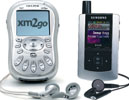
The size of the new radios is their most remarkable feature. The Inno and Helix are 60% smaller than the previous generation radio. A volume reduction of this magnitude places extraordinary demands on the performance of the radio and, in particular, on the antenna.
Antenna matters
Antenna size really does matter. All things equal, a large antenna is a more efficient signal delivery mechanism than a small antenna. For a satellite service like XM, delivering as much signal as possible to the receiver over the noise inherent in small electronic boxes is critical to ensuring a satisfactory listening experience - probably even more so than with conventional analog radio because with digital, fade means silence.
In the first generation of XM2GO products, a conventional patch antenna provided the first link in the receiver chain. Patch antennas are a square slab of ceramic plated with copper and off-centre fed to excite a phased pair of dipoles that create resonance sympathetic to circular polarisation. A difficulty with the patch antenna is that it is a single-ended structure that requires a ground plane 3-4 times the surface area of the antenna itself. In practice, the ground plane coupled to the antenna is continuous with the chassis of the receiving device, increasing the antenna's apparent size and thus, its efficiency.
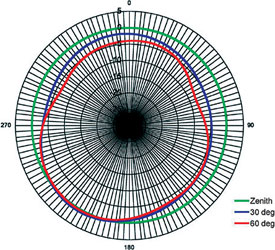
Unfortunately, the requirements of industrial design and product aesthetics rarely allow the designer to place a patch antenna in an ideal position within the receiver, nor do they allow ground planes of sufficient size and symmetry to form the ideal receiving pattern. The resulting impact on antenna performance leads to a narrowing of the antenna's beamwidth. This, in turn, leads to poor low-elevation reception, a loss of circular polarisation, and lower signal-to-noise figures.
To complicate matters, the presence of a ground plane - of any size or symmetry - has the effect of coupling noise from screens, oscillators, processors, etc, directly into the receiver chain. Out-of-band noise can be filtered out, but spurious in-band noise is coupled directly into the signal from the antenna, lowering the signal-to-noise ratio.
Therefore, while the task of reducing the size of the radio usually falls upon those engineers integrating functions into more capable ASICs, the task of maintaining - or hopefully improving - radio performance falls upon the antenna designer. In other words, how does the antenna designer make the antenna look larger, while keeping within the bounds of good product aesthetics and avoiding the pitfalls of RF-stomping common mode noise?
The SkyTune advantage
In this case, XM turned to Sarantel's new SkyTune S-band antenna for the SDARS (satellite digital audio radio service) RF spectrum at 2,3 GHz. The SkyTune antenna is based on Sarantel's PowerHelix filtering antenna technology. PowerHelix antennas are balanced twisted-loop antennas plated onto a dielectric cylinder, single-end-fed but transformed to balanced, by an integrated sleeve balun on the antenna structure. These antennas have a number of features of note for services like satellite radio. Balanced antennas do not require a ground plane; therefore:
* They reject common mode noise resident on ground planes in the radio.
* The dielectric material shrinks them to a physically small size (SkyTune is 17 mm long by 10 mm diameter).
* They do not couple with the chassis of the device; therefore, their reception pattern and polarisation are platform-independent.
* They do not de-tune when near people or objects (more on this later).
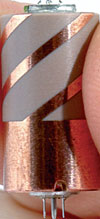
The SkyTune antenna is a style of antenna known as a quadrifilar helix. A quadrifilar helix antenna consists of opposing loop antennas in quadrature phase. Each loop forms a dipole which, by phasing 90°, has the effect of spinning to create circular polarisation. Because it is a balanced antenna, it does not rely on a ground plane to form a good, circular polarisation pattern. This pattern provides the broadest beamwidth for excellent low elevation reception. Balanced antennas are also incapable of coupling common-mode noise from single-ended sources, like the handset ground. This yields a higher signal-to-noise figure in the receiver, resulting in better listening performance at lower signal levels.
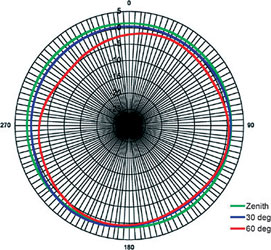
The size of the SkyTune antenna is determined by the length of the loops required to resonate at the SDARS frequency (2,3 GHz) and the dielectric constant of the material used as the antenna's substrate. The dielectric material chosen has three notable consequences. First, as the relative dielectric grows, the antenna becomes physically smaller. Second, dielectric losses can impact the antenna's efficiency - after all, a dielectric wants to be a capacitor rather than a resonator. Third, dielectrically-loaded antennas tend to have very narrow bandwidth. Therefore, a balance must be struck between antenna size, bandwidth, and desired performance. Sarantel found that a slightly lower dielectric material than is used in its GeoHelix GPS antennas would allow a higher frequency antenna to be plated on the same size cylinder.
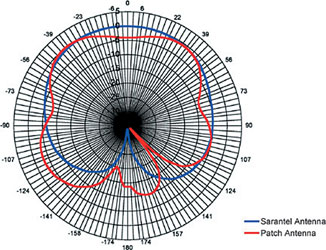
Because the physical antenna size is the same at a higher frequency, the electrical size of the SkyTune antenna is approximately double the electrical size of the GPS antenna. This, combined with lower dielectric losses due to the lower relative dielectric constant of the substrate material, results in isotropic or better peak gain for the SkyTune antenna in the SDARS band. Further, because it is an electrically larger antenna than its GPS cousin, this gain is spread over a wider bandwidth. While still narrower than conventional air-loaded antennas, the SkyTune has sufficient bandwidth to cover the XM band (12,5 MHz) but also has the desirable characteristic of a sharp filtering response outside that band.
Finally, the user impact on the receiving system must be taken into consideration. All antennas store resonance energy in the air surrounding the antenna. Since air has a relative dielectric constant of 1, any material with a higher dielectric constant intersecting with that energy field will act as a sponge, soaking the energy from the air and thus, decreasing the antenna's efficiency. The smaller the antenna and radio, the worse the problem of user-loading on the receiving system. By loading the antenna with a high dielectric material and isolating it from the radio through balance and the integrated sleeve balun, the SkyTune antenna greatly minimises the user effects on the receiver. By constraining this near-field reservoir to a very small space by putting a high dielectric into the antenna structure itself, the user's hand and body seldom come in close contact with it. Theoretically, the radio can be made as small as the SkyTune antenna without loss of receiver efficiency - assuming, of course, that the receiver can be packed into a volume that small!
A bright future for satellite radio
Satellite radio has a very bright future, particularly as designers continue to innovate in the ways content is delivered to listeners. XM has delivered a new generation of attractive, feature-rich, highly portable radios that promise to make content available anywhere. Sarantel's SkyTune antenna is a major contributing factor to the successful reduction in size of the XM2GO products. In the future, as advances in receiver and component miniaturisation further shrink the size of the electronics, the SkyTune antenna will provide maximum performance regardless of the size of the platform.

© Technews Publishing (Pty) Ltd | All Rights Reserved